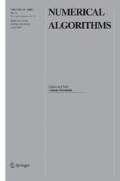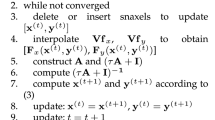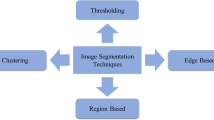Abstract
In this paper, we propose a new 2D segmentation model including geometric constraints, namely interpolation conditions, to detect objects in a given image. We propose to apply the deformable models to an explicit function using the level set approach (Osher and Sethian [24]); so, we avoid the classical problem of parameterization of both segmentation representation and interpolation conditions. Furthermore, we allow this representation to have topological changes. A problem of energy minimization on a closed subspace of a Hilbert space is defined and introducing Lagrange multipliers enables us to formulate the corresponding variational problem with interpolation conditions. Thus the explicit function evolves, while minimizing the energy and it stops evolving when the desired outlines of the object to detect are reached. The stopping term, as in the classical deformable models, is related to the gradient of the image. Numerical results are given.
Similar content being viewed by others
References
A.A. Amini, S. Tehrani and T.E. Weymouth, Using dynamic programming for minimizing the energy of active contours in the presence of hard constraints, in: Proc. of the Second ICCV (1988) pp. 95–99.
D. Apprato, J.B. Betbeder, C. Gout and S. Vieira-Testé, A segmentation method under geometric constraints and after pre-processing, in: Curves and Surfaces, Vol. IV, eds. A. Cohen, C. Rabut and L.L. Schumaker (Vanderbilt Univ. Press, Nashville, TN, 1999) pp. 9–18.
D. Apprato and C. Gout, A result about scale transformation families in approximation: Application to surface fitting from rapidly varying data, Numer. Algorithms 23(2/3) (2000) 263–279.
F.K. Bogner, R.L. Fox and L.A. Schmit, The generation of interelement-compatible stiffness and mass matrices by the use of interpolation formulae, in: Proc. of Conf. on Matrix Methods in Struct. Mech., Air Force Inst. of Tech., Wright Patterson A.F. Base, OH (October 1965).
V. Caselles, F. Catté, T. Coll and F. Dibos, A geometric model for active contours in image processing, Numer. Math. 66 (1993) 1–31.
V. Caselles, R. Kimmel and G. Sapiro, Geodesic active contours, Internat. J. Computer Vision 22(1) (1997) 61–79.
P.G. Ciarlet, Introduction à l’Analyse Matricielle et à l’Optimisation (Masson, Paris, 1985).
P.G. Ciarlet, The Finite Element Method for Elliptic Problems (North-Holland, Amsterdam, 1987).
I. Cohen, Modèles déformables 2D et 3D: Application à la segmentation d’images médicales, thèse de l’Université de Paris IX–Dauphine (1992).
I. Cohen, L.D. Cohen and N. Ayache, Using deformable surfaces to segment 3D images and infer differential structures, Computer Vision Graphics Image Process. 56(2) (1992) 242–263.
L.D. Cohen, On active contours models and balloons, Computer Vision Graphics Image Process. 53(2) (1991) 211–218.
L.D. Cohen, E. Bardinet and N. Ayache, Surface reconstruction using active contour models, INRIA, Rapport de recherche (1992).
L.D. Cohen and I. Cohen, Finite Element methods for active contour models and balloons from 2D to 3D, IEEE Trans. Pattern Anal. Mach. Intelligence 15(11) (1993).
P. Faurre, Cours d’Analyse Numérique – Notes d’Optimisation (Ecole Polytechnique, 1982).
C. Gout, Ck surface approximation from surface patches, Comput. Math. Appl. 44(3/4) (2002) 389–406.
C. Gout, C. Le Guyader and L. Vese, Segmentation under geometrical conditions using geodesic active contours and interpolation using level set methods (2004) submitted.
C. Gout and S. Vieira-Testé, Using deformable models to segment complex structures under geometric constraints, in: IEEE Symposium on Image Analysis and Interpretation, Austin (2000) pp. 101–105.
M. Kass, A.P. Witkin and D. Terzopoulos, Snakes: Active contour models, Internat. J. Computer Vision 1(4) (1987) 133–144.
C. Le Guyader, Imagerie mathématique: Théory et applications, Thèse de doctorat, INSA, Rouen, en cours de rédaction.
J.L. Lions and E. Magenes, Problèmes aux Limites non Homogènes et Applications (Dunod, Paris, 1968).
R. Malladi and J.A. Sethian, Image processing via level set curvature flow, Proc. National Acad. Sci. 92(15) (1995) 7046–7050.
T. McInerney and D. Terzopoulos, Topology adaptive deformable surfaces for medical image volume segmentation, IEEE Trans. Medical Imaging 18(10) (1999) 840.
S. Osher and R. Fedkiw, Level Set Methods and Dynamic Implicit Surfaces (Springer, Berlin, 2003).
S. Osher and J.A. Sethian, Fronts propagating with curvature dependent speed: Algorithms based on Hamilton–Jacobi formulations, J. Comput. Phys. 79 (1988) 12–49.
J.A. Sethian, A fast level set method for monotically advancing fronts, Proc. National Acad. Sci. (1995) submitted.
J.A. Sethian, Level Set Methods and Fast Marching Methods: Evolving Interfaces in Computational Geometry, Fluid Mechanics, Computer Vision, and Materials Science (Cambridge Univ. Press, London, 1999).
J.A. Sethian, Evolution, implementation and application of level set and fast marching methods for advancing fronts, J. Comput. Phys. 169(2) (2001) 503–555.
M. Sonka, V. Hlavac and R. Boyle, Image Processing, Analysis and Machine Vision (Chapman & Hall, London, 1993).
D. Terzopoulos, A. Witkin and M. Kass, Symmetry seeking models for 3D object reconstruction, in: Proc. of the First Internat. Conf. on Computer Vision, London, England (IEEE, Piscataway, NJ, 1987) pp. 269–276.
S. Vieira-Testé, Représentation de structures géologiques à l’aide de modèles déformables sous contraintes géométriques, Thèse de l’Université de Pau et des Pays de l’Adour (1997).
Author information
Authors and Affiliations
Corresponding author
Additional information
AMS subject classification
74G65, 46-xx, 92C55
Rights and permissions
About this article
Cite this article
Le Guyader, C., Apprato, D. & Gout, C. Using a level set approach for image segmentation under interpolation conditions. Numer Algor 39, 221–235 (2005). https://doi.org/10.1007/s11075-004-3631-z
Received:
Accepted:
Issue Date:
DOI: https://doi.org/10.1007/s11075-004-3631-z




